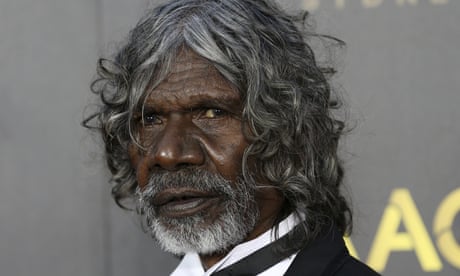- by foxnews
- 08 Apr 2025
David Dalaithngu obituary: Walkabout star a ?consummate actor? who helped reinvent Australian film
David Dalaithngu obituary: Walkabout star a ‘consummate actor’ who helped reinvent Australian film
- by theguardian
- 30 Nov 2021
- in news

The charismatic actor, mesmerising dancer and cultural icon David Dalaithngu is finally going home. Dalaithngu, of the Mandhalpuyngu clan in Arnhem Land, spent his final years battling lung cancer in the care of his friend Mary Hood in Murray Bridge, in South Australia. He often said how much he missed his country but understood his deteriorating health made it impossible to travel.
With his trademark dry humour, Dalaithngu told film-maker and friend Molly Reynolds in 2020 that he was "going back to country on a one-way ticket". He died on Monday aged 68.
Dalaithngu said he was born "under a tree" and grew up steeped in his culture. A gifted young performer, he used the rangy elegance of his frame to tell a story, a skill that he adapted to his film career.
"I don't have to go and act. I just jump in and stand there and the camera sees me," Dalaithngu told Reynolds. It was their final collaboration, a powerful film he called "my story of my story" released earlier this year to wide acclaim. The name of the film cannot be used as it contains his name; his family have requested that he be referred to as Dalaithngu for the time being.
At 15, he was already an accomplished hunter, tracker and ceremonial dancer. In 1969 when English film director Nicolas Roeg toured to Arnhem Land scouting locations for a forthcoming film, he asked elders - no strangers to film-making thanks to visits from anthropologist Donald Thomson - who was their best young dancer. According to Dalaithngu, they all pointed at him. He was 16 when Walkabout was released, his first film. For the role he added English to the many Indigenous languages in which he was already fluent.
Dalaithngu became an instant global celebrity. As a fresh faced, besuited young man he went from Arnhem Land to London, where he met the Queen, then Paris and beyond. He mingled with John Lennon and Muhammad Ali. He hung out with Bruce Lee, played yidaki (didjeridu) with Jimi Hendrix and Bob Marley.
His role in Walkabout is credited with helping bring an end to the use of blackface in Australian cinema. Until his arrival on the screen, with the exception of Rosemary Kunoth-Monks and Robert Tudawali in Charles Chauvel's Jedda (1956), the custom had been for white actors to play Indigenous characters. Aboriginal people had been portrayed by non-Aboriginal actors, including Ed Devereaux and Kamahl (Journey Out of Darkness, 1967).
Dalaithngu also experienced the wild Hollywood lifestyles of his co-stars. At the age of 20, he was filming Mad Dog Morgan (1976) with Dennis Hopper and John Meillon.
"If you're working with people like Dennis Hopper and Meillon, well, you gotta learn all about drinking and drugs. It was the 1970s. I thought well, I got to join in this whitefella corroboree. But I tell you, I'd never seen anything like this before," he said in his 2004 one-man stage show.
Dalaithngu had a string of successful roles in the 1970s including in Storm Boy (1976) and The Last Wave (1977). But his longest creative collaboration was with director Rolf de Heer, with whom he worked for more than 15 years. Together they crafted The Tracker (2002) for which Dalaithngu won an Aactar award, Ten Canoes (2006) and Charlie's Country (2014) for which Dalaithngu won best actor in Cannes' Un Certain Regard section.
De Heer described Dalaithngu as a "consummate actor", who rarely required direction.
"When I first met David, I didn't know how I would ever direct him in a film. We were so culturally far apart," de Heer told the ABC in 2015.
In The Tracker (2002), Dalaithngu embodies silence. He brings an economy of movement and subtle reactions, and uses Aboriginal sign and body language. It was important to Dalaithngu to bring a true representation of his countrymen and their inner lives to the screen. He told Reynolds that films would tell the story of his life, of Aboriginal life, for future generations to see. History couldn't rub it out.
"Acting came natural to me," he said. "I know how to walk across the land in front of a camera, because I belong there."
- by foxnews
- descember 09, 2016
Ancient settlement reveals remains of 1,800-year-old dog, baffling experts: 'Preserved quite well'
Archaeologists have recently unearthed the remarkably well-preserved remains of a dog from ancient Rome, shedding light on the widespread practice of ritual sacrifice in antiquity.
read more


